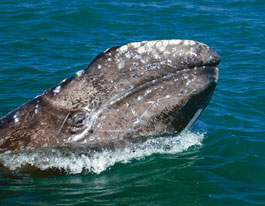home | north bay bohemian index | news | north bay | news article

Photograph by Geoff Shester
EYE OF THE STORM: Gray whales, which were taken off the endangered species list in 1994, are once again in peril.
Gray Whale Endgame?
With hunters on one side and climate upheaval on the other, gray whales' numbers are dropping
By Alastair Bland
Each March, gray whales by the thousands flood into the large lagoons of Baja California's Pacific Coast to give birth. The animals congregate densely, and as boatloads of tourists move in to watch, the whales vocalize and sing to one another across the still waters.
"You can hear them all across the lagoon, singing and talking," says Sue Arnold, CEO of the California Gray Whale Coalition. "But this year it was silent. It was spooky."
The whales, she explains, did not show up in their usual numbers, making this the fourth consecutive year the eastern Pacific population of grays, for various unclear reasons, has struggled to reproduce.
And as the California Gray Whale Coalition and other environmental groups push an effort to relist the gray whale under the Endangered Species Act, the animal's most dangerous enemies have recently introduced a proposal to continue the annual hunt for the whales in the northwest Pacific, where indigenous Russian hunters are allowed to take 140 of the animals every year.
At its annual summit, now ongoing in Morocco through June 11, the International Whaling Commission will decide to accept or reject a new proposal to extend the Russians' annual harvest of gray whales for at least 10 years beginning in 2011. The proposal includes population figures intended to lend credibility to the bid.
"But the whale population numbers aren't being properly presented," says Sarah Graham, the West Coast manager of the California Gray Whale Coalition. "They're using 2006's numbers as evidence that it's OK to keep hunting [gray whales]."
The 2006 estimate of just under 20,000 individuals was collected and provided by the National Oceanic and Atmospheric Administration (NOAA). Fisheries biologist for the NOAA Wayne Perryman says the next estimate, based on this year's count of gray whales as they pass north and south along the coast, won't be available until the end of 2011 at the earliest.
The new proposal on grays comes as part of a broader development at the International Whaling Commission that has environmentalists outraged. In a seemingly counterintuitive move, the nations opposed to whaling (that is, most nations, including the United States) are offering to lift the 24-year moratorium on commercial whaling in exchange for a concession by the pro-whaling nations that will reportedly reduce the number of whales killed annually. (Only Japan, Iceland and Norway formally support the practice, while Russia, the United States, Canada, Greenland, and St. Vincent and the Grenadines allow limited take for indigenous peoples.)
"This is obscene because the anti-whaling countries are sitting down with the pro-whaling countries and asking, 'How can we please you?'" says Arnold of the Morocco meeting.
Whaling opponents say the proposed extension of gray whale hunting comes at a dire time for the animals, whose prime Arctic feeding grounds, where the whales fatten for six months of the year, have been heavily impacted by global warming. In these northern waters, gray whales eat plankton that in turn subsist on algae that precipitate from coastal ice floes.
As Arctic sea ice disappears due to long-term warming, this food chain has been severely disrupted. As a result, says Graham, gray whale adults are failing to acquire the energy reserves they need to migrate southward to their calving grounds within the lagoons of coastal Baja California.
Perryman acknowledges the decline in breeding activity.
"The number of calves born in the last four years has been low," he says. "That's a fact."
For example, in Ojos de Liebres, one of the most important birthing lagoons in Baja, about 2,000 mothers with calves appeared in 2007. This winter, just 578 were counted. And whereas observers counted 417 mother whales in Laguna San Ignacio in 2006, in 2009 they saw just 201.
But Perryman suspects that weather complications—and less so long-term climate change—are the cause of the depressed breeding activity in Baja's coastal lagoons. Thus, the poor annual calf recruitment might reverse any year, he says.
The California Gray Whale Coalition is advocating a return of the gray whale to the endangered species list, at least under the status of "threatened." Arnold says the process will be a "daunting" one "that can take years." The gray whale was delisted in 1994 after a dramatic recovery from the verge of extinction.
Perryman, who believes the gray whale's numbers along the West Coast of North America "are slowly increasing or stable," stresses that NOAA and nonprofit organizations "have common goals and common concerns" relating to marine conservation and protection of whales.
"But," he says, "we don't want to rush judgment on these issues."
Send a letter to the editor about this story.
|
|
|
|
|
|